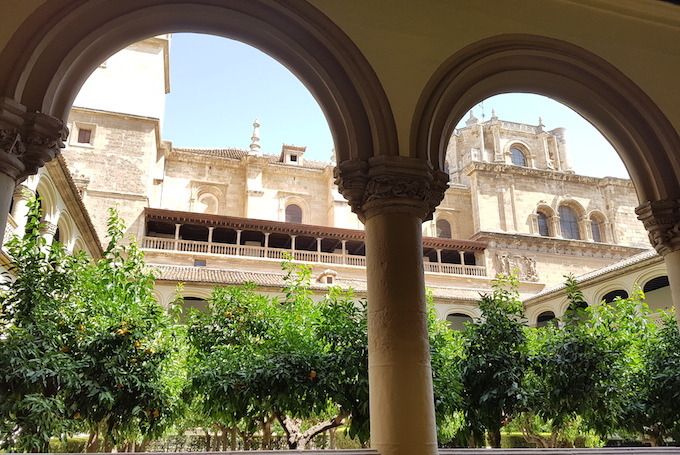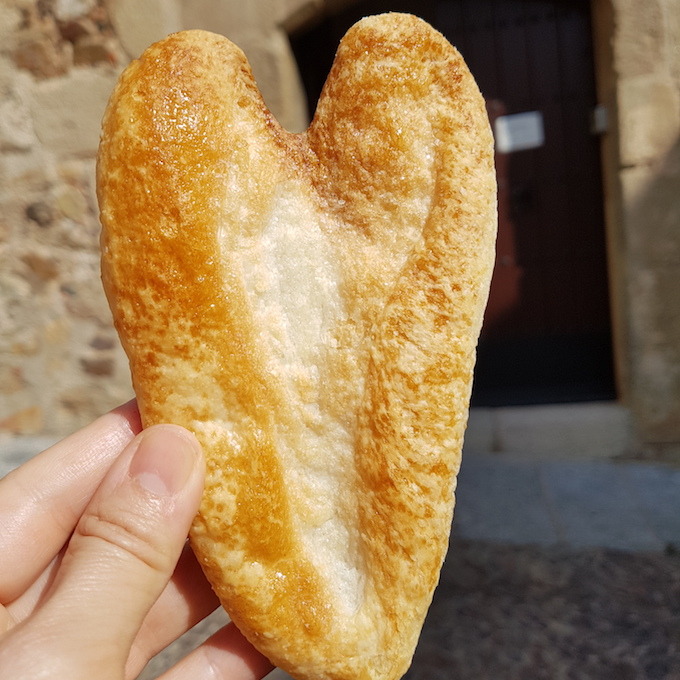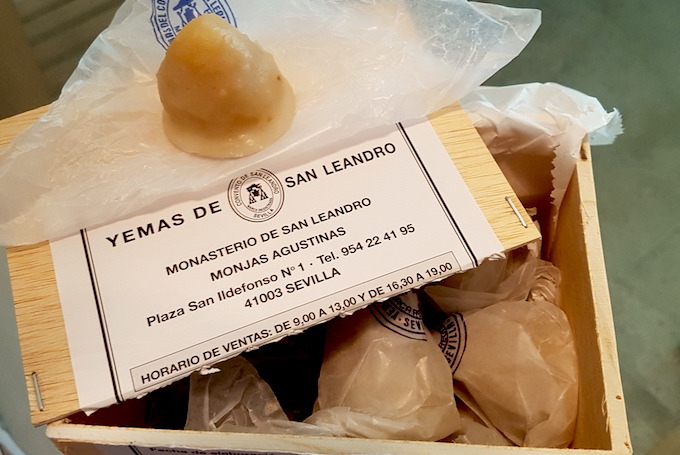Homemade Treats At Convents In Spain
A heavenly pursuit through the traditional homemade delights of Spain's convents
The man standing in front of the dimly lit walled-in counter looks a little lost. He doesn't speak much Spanish, so he's flummoxed when he hears a quiet Ave Maria from the other side. "I'd like to buy some dulces (sweets), por favor," he says in Spanglish, looking at me hopefully, as I translate while pointing to the counter, where pastas de té (cookies), palmeritas (puff pastry sugared palmiers) and other treats are listed and priced on a menu. We're in the historic city of Cáceres, Spain, at the Convento San Pablo where cloistered nuns are selling storied sweets.
The man settles on the sugar cookies, pops his Euros into the turnstile and is rewarded with a box of biscuits. This is an oft-repeated transaction throughout Spain, especially in the south. Cloistered nuns (and some more modern orders) keep the centuries-old traditions of making marmalades, jams, cakes, cookies and candies alive and well. This isn't just a hobby—it's their livelihood, as the proceeds cover their living expenses. I spent time traversing over 1,500 miles through 13 cities with my family, including at least one convent per city, and emerged with the following memorable heavenly Spanish sweets.
Convento de San Antonio, Toledo
We start in Toledo, a 2,500-year-old city about 30 minutes south of Madrid. Tourists from around the globe (religious and non-religious alike) drop their Euros into turnstiles, much like the man in Cáceres, but in this city, the nuns have gotten used to tourist traffic and opened a boîte-like shop in front of their convent. And the young woman selling the goodies isn't a nun.
Ingredients used in these treats date back to Roman times—as do the recipes. Spanish pork lard, wild honey, almonds, spices, raisins and Seville oranges grace a variety of sweets. At Convento San Antonio, the pork lard-based mantecados (a favorite Christmas sweet) practically disintegrate in your mouth, earning enthusiastic nods from my family, and the roscas (a sturdy, rolled cookie) made with orange juice, anise, extra-virgin olive oil and eggs are perfect with a cafe con leche. But it's the toledanas, a lard-enhanced turnover-like pastry with confitured pumpkin threads, wine, almond and cinnamon that really grabs our attention. Flaky, flavorful and of the region—these hit all of the right notes without being too sweet.
Convento de Zafra, Granada
Five hours south of Toledo sits the historic city of Granada, home of the Alhambra and the medieval Moorish neighborhood of Albaycin, where this convent is located. The decision to drive there seems increasingly like it's not the best choice, as we navigate our German rental car through a narrow alleyway masquerading as a street. We squeak past with flattened side mirrors to a crowd of locals stands at the other end of the opening, cheering us on as we finally exit. Hallelujah!
Once we reach the convent, we order the pastas de té (tea biscuits) laced with anise and almond, as well as a box of roscos de aceite (extra-virgin olive oil bread knots). The pastas de té are like the white bread of Spain— they're everywhere, and while perfectly pleasant, they're about as memorable as vanilla—no offense to vanilla lovers. The roscos are one of the few nun-made creations that aren't sweet. They're more on the savory side and would be perfect on a charcuterie board . . . which we proceed to compile with some excellent organic cheeses from Hacienda Zorita, slices of the country's famous Jamón Iberico and a glass of Rioja. The razor-thin "street" is soon forgotten.
Monasterio De Santa Paula, Sevilla
While technically cloistered, we meet a lively, diminutive sister whose initials are M.F. (she wishes to remain anonymous), who walks us into a tiny tienda (store) inside convent grounds. "Ora et labora," prayer and work, is this order's motto. And here, where they grow their own fruit in the courtyard, you can find a prime example of Seville orange marmalade. Just sweet enough and not overly bitter, with thin slivers of orange suspended throughout. We happily purchase marmalade, figs in syrup and a coffee liqueur for my mom who, like any good Colombian, enjoys just about anything coffee-based.
Meanwhile, this nun is asking my seven-year-old if, in 10 years' time, she'll consider joining the order and making delicacies with them. My daughter gives the sister M.F. a big smile and replies as sweetly as the convent-made marmalades, "I don't think so. I want to be an architect."
Convento de San Leandro, Sevilla
On the other end of town is one of the city's most famous sweets, the yemas de San Leandro, St. Leandro's Yolks. These alchemic treats date back to at least the 13th century and are made with only three ingredients: egg yolks, lemon juice and sugar. The result is a wonderfully rich, sweet mouthful that's made unique in the way the sugar forms a "shell" around the soft, cooked yolk. A little bit is all you need to feel satisfied, and it's like taking a bite out of history.
Iesu Communio, Burgos
Near Valladolid, in the town of Lerma, we make our final stop of the trip at the beautiful convent of the modern sisters of Iesu Communio, which has been around since the 1980s. A few things differentiate these nuns: Most of them have post-secondary educations, they're younger than most orders and some may have even worked in secular jobs before deciding that they felt more spiritually fulfilled in this relatively newer order.
At their Pequeña Reposteria (small confectionary shop), we ring the door expecting another turnstile and a solemn interior. Instead, we find ourselves in a bright shop where two young nuns sporting denim tunics and habits speak freely to us, smiling and explaining how they've taken traditional recipes and given some a bit of an update. There's homemade quince paste, chocolates of all types, roasted nuts that resemble small river rocks, plus hand-piped cookies and jams. Two local men walk in behind us and ask if the sisters have any cakes on hand (others prefer to place orders online). "You're in luck," sister Vida says, presenting a patisserie-quality white cake she explains is a Cava mousse. "That's the one," the man replies, smiling, handing over 20 Euros in exchange for a beautifully crafted cake.
We buy a truffle selection box (which doesn't last beyond the driveway), candied Seville orange slices half-dipped in chocolate and chocolate dusted almonds, which we aim to enjoy post-trip. They're at once an extension of and a counterpoint to the traditional, beautiful sweets we've enjoyed throughout this region of Spain—made sweeter by talented nuns with a modern outlook on spirituality and making dessert. Many outlets of El Corte Inglés, Spain's leading department store, also carry their treats—giving you no excuse to miss out on these divine confections.



